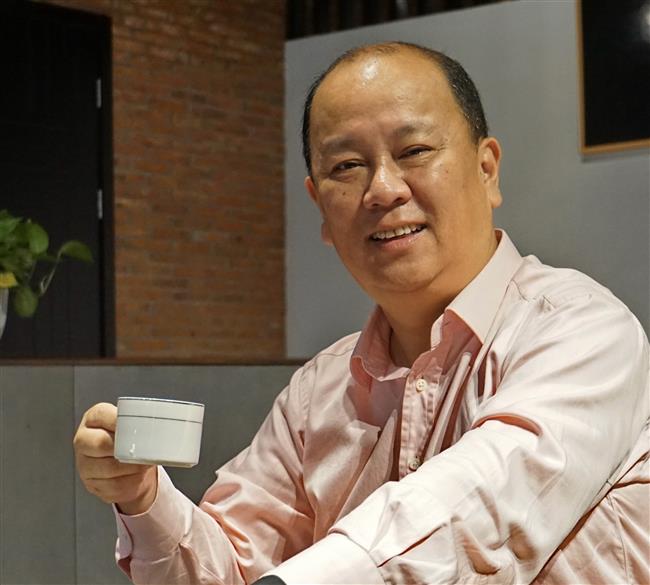A pioneer in China's creative and cultural park development

Part of China's earliest railway, Songhu Rail, has been preserved in the Elite Valley.
Sixteen years ago when He Zengqiang first arrived at today’s 1933 Old Millfun, a creative hub in Hongkou District, it was then the site of an old abattoir, but he had the vision to turn it into the city’s new fashion icon. Back then many people thought it was a crazy idea, yet He made this dream come true in 2006 when he launched a “Ferrari Night” there.
The success made He hungry for more and later he turned to the Elite Valley project to satiate that appetite.
Elite Valley is a new creative and cultural park, which rose from an abandoned industrial site. It was once full of old warehouses used for import and export facilities in north Shanghai’s Baoshan District.
The launch of Elite Valley marked a new round of development of creative and cultural parks in the city’s outskirts. Covering an area of 210,000 square meters, the old warehouses have been renovated into new office buildings, cafeterias, bars and restaurants. Visitors to the area can also find a football pitch, a basketball court and Asia’s largest trampoline center.
The Elite Valley at 258 Changjiang Road caters to different needs, with a supermarket, apartments, a parent-child restaurant, an art museum and a kindergarten.
“Today the cost of living in the downtown area is much expensive, and not everyone can afford to live there. That is why Elite Valley is so appealing,” He says. “I hope to create a new environment.”
Born in 1958 in Shanghai, He served in the army and navy from 1976 to 1998. For 10 years from 2004, he was the secretary-general of the Shanghai Creative Industrial Center; now he is the center’s chairman.
After the 1933 Old Millfun venture, He was involved in nine creative and cultural parks. Based on his experiences and research, he has written several books and is planning reports on the development of creative and cultural industry in Shanghai.

He Zengqiang has been involved in the creative and cultural park industry for over a decade.
Q: When you first came to Elite Valley, what was your impression of the area? What made you confident about making it another redevelopment success?
A: It was in early 2007 when someone first recommended this project to me. At that time I was preoccupied with some other projects and didn’t really have much interest. Actually there is a “commonsense” in our industry: A creative and cultural park outside the downtown area will not work out.
In 2013, I was invited to implement this project again. The whole area was then still in a mess. The Baoshan District government hoped I could overhaul the place and liven up the neighborhood’s atmosphere.
I finally agreed, because at that time space was limited in the downtown area to develop creative and culture parks. And it also made sense as many young people couldn’t afford to live in the city center, so such redevelopment project in the suburbs would serve their needs.
Q: What is the difference between 1933 Old Millfun and Elite Valley?
A: It was almost a decade ago when we developed 1933. Both of them are models of what a creative and cultural park in Shanghai should look like. But they are from different time periods with different modes.
Because of its unique space, 1933 Old Millfun in downtown is a landmark of Shanghai’s creative, musical and fashion industry. Elite Valley is more like a community where young people can work and live comfortably.
The attraction of the community might even draw in residents from outside the neighborhood. I believe Elite Valley will be a good reference for further development in the city’s creative and cultural parks.
Q: What do you think is the key to the prosperity of the creative and cultural parks in Shanghai? Can it be copied in other cities?
A: The manufacturing industry in Shanghai in the 1990s left behind a large quantity of old industrial space, which initiated the development of creative and cultural parks. In this sense, it probably can’t be repeated in other cities.
Moreover, Shanghai’s big population, high consuming ability and fast economic development are also the reasons behind the success.
Q: You were in the army for nearly two decades. What influence has it had on you?
A: It greatly trained my will power. I am a person who does not give up. I prefer to take every solid step in my work.
I am also a person for changes. I hate to repeat myself. You see, not a single creative and cultural park is the same. I think this is the key to my success.
Q: You said that the Elite Valley is “people-oriented,” how did you come up with this idea?
A: I always observe the market. I like to communicate with young people. There are many in my company, who were born in the 1980s and 1990s. Most of them want a decent job with convenient transport, plain interpersonal relation and a nice boss.
In my eyes, the employees seem stronger than the employers. The core of a company is people, and how to retain those people you need is an issue that each manager faces.


















